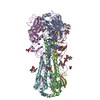[English] 日本語
 Yorodumi
Yorodumi- EMDB-45328: Polyclonal immune complex of Fab binding the H1 HA from serum of ... -
+ Open data
Open data
- Basic information
Basic information
| Entry |  | |||||||||
|---|---|---|---|---|---|---|---|---|---|---|
| Title | Polyclonal immune complex of Fab binding the H1 HA from serum of donor 2 at day 14 | |||||||||
 Map data Map data | Negative stain map of global refinement of particle stack used to sort polyclonal responses to H1 HA from human donor 2 at day 14 | |||||||||
 Sample Sample |
| |||||||||
 Keywords Keywords | influenza / hemagglutinin / H1 / polyclonal complex / Fab complex / viral fusion protein / VIRAL PROTEIN / VIRAL PROTEIN-IMMUNE SYSTEM complex | |||||||||
| Biological species |  Homo sapiens (human) Homo sapiens (human) | |||||||||
| Method | single particle reconstruction / negative staining / Resolution: 25.0 Å | |||||||||
 Authors Authors | Leon AN / Rodriguez AJ / Richey ST / Torrents de la Pena A / Jackson AM / Han J / Ward AB | |||||||||
| Funding support |  United States, 1 items United States, 1 items
| |||||||||
 Citation Citation |  Journal: mBio / Year: 2025 Journal: mBio / Year: 2025Title: Structural mapping of polyclonal IgG responses to HA after influenza virus vaccination or infection. Authors: André Nicolás León / Alesandra J Rodriguez / Sara T Richey / Alba Torrents de la Pena / Rachael M Wolters / Abigail M Jackson / Katherine Webb / C Buddy Creech / Sandra Yoder / Philip A ...Authors: André Nicolás León / Alesandra J Rodriguez / Sara T Richey / Alba Torrents de la Pena / Rachael M Wolters / Abigail M Jackson / Katherine Webb / C Buddy Creech / Sandra Yoder / Philip A Mudd / James E Crowe / Julianna Han / Andrew B Ward /  Abstract: Cellular and molecular characterization of immune responses elicited by influenza virus infection and seasonal vaccination have informed efforts to improve vaccine efficacy, breadth, and longevity. ...Cellular and molecular characterization of immune responses elicited by influenza virus infection and seasonal vaccination have informed efforts to improve vaccine efficacy, breadth, and longevity. Here, we use negative stain electron microscopy polyclonal epitope mapping (nsEMPEM) to structurally characterize the humoral IgG antibody responses to hemagglutinin (HA) from human patients vaccinated with a seasonal quadrivalent flu vaccine or infected with influenza A viruses. Our data show that both vaccinated and infected patients had humoral IgGs targeting highly conserved regions on both H1 and H3 subtype HAs, including the stem and anchor, which are targets for universal influenza vaccine design. Responses against H1 predominantly targeted the central stem epitope in infected patients and vaccinated donors, whereas head epitopes were more prominently targeted on H3. Responses against H3 were less abundant, but a greater diversity of H3 epitopes were targeted relative to H1. While our analysis is limited by sample size, on average, vaccinated donors responded to a greater diversity of epitopes on both H1 and H3 than infected patients. These data establish a baseline for assessing polyclonal antibody responses in vaccination and infection, providing a context for future vaccine trials and emphasizing the need for further characterization of protective responses toward conserved epitopes. (201 words)IMPORTANCESeasonal influenza viruses cause hundreds of thousands of deaths each year and up to a billion infections; under the proper circumstances, influenza A viruses with pandemic potential could threaten the lives of millions more. The variable efficacies of traditional influenza virus vaccines and the desire to prevent pandemic influenzas have motivated work toward finding a universal flu vaccine. Many promising universal flu vaccine candidates currently focus on guiding immune responses to highly conserved epitopes on the central stem of the influenza hemagglutinin viral fusion protein. To support the further development of these stem-targeting vaccine candidates, in this study, we use negative stain electron microscopy to assess the prevalence of central stem-targeting antibodies in individuals who were exposed to influenza antigens through traditional vaccination and/or natural infection during the 2018-2019 flu season. | |||||||||
| History |
|
- Structure visualization
Structure visualization
| Supplemental images |
|---|
- Downloads & links
Downloads & links
-EMDB archive
| Map data |  emd_45328.map.gz emd_45328.map.gz | 11.9 MB |  EMDB map data format EMDB map data format | |
|---|---|---|---|---|
| Header (meta data) |  emd-45328-v30.xml emd-45328-v30.xml emd-45328.xml emd-45328.xml | 18.8 KB 18.8 KB | Display Display |  EMDB header EMDB header |
| Images |  emd_45328.png emd_45328.png | 25.6 KB | ||
| Filedesc metadata |  emd-45328.cif.gz emd-45328.cif.gz | 4.7 KB | ||
| Others |  emd_45328_additional_1.map.gz emd_45328_additional_1.map.gz emd_45328_half_map_1.map.gz emd_45328_half_map_1.map.gz emd_45328_half_map_2.map.gz emd_45328_half_map_2.map.gz | 5.9 MB 11.9 MB 11.9 MB | ||
| Archive directory |  http://ftp.pdbj.org/pub/emdb/structures/EMD-45328 http://ftp.pdbj.org/pub/emdb/structures/EMD-45328 ftp://ftp.pdbj.org/pub/emdb/structures/EMD-45328 ftp://ftp.pdbj.org/pub/emdb/structures/EMD-45328 | HTTPS FTP |
-Validation report
| Summary document |  emd_45328_validation.pdf.gz emd_45328_validation.pdf.gz | 572.1 KB | Display |  EMDB validaton report EMDB validaton report |
|---|---|---|---|---|
| Full document |  emd_45328_full_validation.pdf.gz emd_45328_full_validation.pdf.gz | 571.5 KB | Display | |
| Data in XML |  emd_45328_validation.xml.gz emd_45328_validation.xml.gz | 9.7 KB | Display | |
| Data in CIF |  emd_45328_validation.cif.gz emd_45328_validation.cif.gz | 11.3 KB | Display | |
| Arichive directory |  https://ftp.pdbj.org/pub/emdb/validation_reports/EMD-45328 https://ftp.pdbj.org/pub/emdb/validation_reports/EMD-45328 ftp://ftp.pdbj.org/pub/emdb/validation_reports/EMD-45328 ftp://ftp.pdbj.org/pub/emdb/validation_reports/EMD-45328 | HTTPS FTP |
-Related structure data
| Related structure data | C: citing same article ( |
|---|
- Links
Links
| EMDB pages |  EMDB (EBI/PDBe) / EMDB (EBI/PDBe) /  EMDataResource EMDataResource |
|---|
- Map
Map
| File |  Download / File: emd_45328.map.gz / Format: CCP4 / Size: 15.6 MB / Type: IMAGE STORED AS FLOATING POINT NUMBER (4 BYTES) Download / File: emd_45328.map.gz / Format: CCP4 / Size: 15.6 MB / Type: IMAGE STORED AS FLOATING POINT NUMBER (4 BYTES) | ||||||||||||||||||||||||||||||||||||
|---|---|---|---|---|---|---|---|---|---|---|---|---|---|---|---|---|---|---|---|---|---|---|---|---|---|---|---|---|---|---|---|---|---|---|---|---|---|
| Annotation | Negative stain map of global refinement of particle stack used to sort polyclonal responses to H1 HA from human donor 2 at day 14 | ||||||||||||||||||||||||||||||||||||
| Projections & slices | Image control
Images are generated by Spider. | ||||||||||||||||||||||||||||||||||||
| Voxel size | X=Y=Z: 2.06 Å | ||||||||||||||||||||||||||||||||||||
| Density |
| ||||||||||||||||||||||||||||||||||||
| Symmetry | Space group: 1 | ||||||||||||||||||||||||||||||||||||
| Details | EMDB XML:
|
-Supplemental data
-Additional map: Negative stain map of polyclonal Fab binding the...
| File | emd_45328_additional_1.map | ||||||||||||
|---|---|---|---|---|---|---|---|---|---|---|---|---|---|
| Annotation | Negative stain map of polyclonal Fab binding the H1 HA tophead and central stem epitopes from human donor 2 at day 14 | ||||||||||||
| Projections & Slices |
| ||||||||||||
| Density Histograms |
-Half map: Negative stain map of half map B for...
| File | emd_45328_half_map_1.map | ||||||||||||
|---|---|---|---|---|---|---|---|---|---|---|---|---|---|
| Annotation | Negative stain map of half map B for global refinement of particle stack used to sort polyclonal responses to H1 HA from human donor 2 at day 14 | ||||||||||||
| Projections & Slices |
| ||||||||||||
| Density Histograms |
-Half map: Negative stain map of half map A for...
| File | emd_45328_half_map_2.map | ||||||||||||
|---|---|---|---|---|---|---|---|---|---|---|---|---|---|
| Annotation | Negative stain map of half map A for global refinement of particle stack used to sort polyclonal responses to H1 HA from human donor 2 at day 14 | ||||||||||||
| Projections & Slices |
| ||||||||||||
| Density Histograms |
- Sample components
Sample components
-Entire : Polyclonal immune complex of Fab binding the H1 HA from serum of ...
| Entire | Name: Polyclonal immune complex of Fab binding the H1 HA from serum of donor 2 at day 14 |
|---|---|
| Components |
|
-Supramolecule #1: Polyclonal immune complex of Fab binding the H1 HA from serum of ...
| Supramolecule | Name: Polyclonal immune complex of Fab binding the H1 HA from serum of donor 2 at day 14 type: complex / ID: 1 / Parent: 0 |
|---|---|
| Source (natural) | Organism:  Homo sapiens (human) Homo sapiens (human) |
| Molecular weight | Theoretical: 280 KDa |
-Experimental details
-Structure determination
| Method | negative staining |
|---|---|
 Processing Processing | single particle reconstruction |
| Aggregation state | particle |
- Sample preparation
Sample preparation
| Concentration | 0.015 mg/mL |
|---|---|
| Buffer | pH: 7.4 |
| Staining | Type: NEGATIVE / Material: 2% w/v uranyl formate |
| Grid | Model: Homemade / Material: COPPER / Mesh: 400 / Support film - Material: CARBON / Pretreatment - Type: GLOW DISCHARGE |
- Electron microscopy
Electron microscopy
| Microscope | FEI TECNAI SPIRIT |
|---|---|
| Image recording | Film or detector model: FEI EAGLE (4k x 4k) / Average electron dose: 25.0 e/Å2 |
| Electron beam | Acceleration voltage: 200 kV / Electron source: LAB6 |
| Electron optics | Illumination mode: FLOOD BEAM / Imaging mode: DARK FIELD / Nominal defocus max: -2.0 µm / Nominal defocus min: -2.0 µm |
| Sample stage | Specimen holder model: SIDE ENTRY, EUCENTRIC |
| Experimental equipment |  Model: Tecnai Spirit / Image courtesy: FEI Company |
- Image processing
Image processing
| Startup model | Type of model: PDB ENTRY PDB model - PDB ID: Details: generated 40A map in chimera |
|---|---|
| Final reconstruction | Resolution.type: BY AUTHOR / Resolution: 25.0 Å / Resolution method: FSC 0.5 CUT-OFF / Software - Name: RELION (ver. 3.0) / Number images used: 22800 |
| Initial angle assignment | Type: MAXIMUM LIKELIHOOD |
| Final angle assignment | Type: MAXIMUM LIKELIHOOD |
 Movie
Movie Controller
Controller



















































 Z (Sec.)
Z (Sec.) Y (Row.)
Y (Row.) X (Col.)
X (Col.)













































